- Karachay folk music
- Special tunes
- The classes of Karachay folk music
- Class 1: Rotating and plagal motion (№ 1−8)
- Class 2: One or two short lines and their variations with x(1)1 cadences (№ 9-37)
- Class 3: Four short lines with (1) main cadence (№ 38-53)
- Class 4: Four short lines with the first line ending on the key note, with a (pseudo) domed structure and 1(x)y cadences (№ 54−62)
- Class 5: Four short lines with (VII) main cadence (№ 63−70)
- Class 6: Four short lines with (2) and (b3) main cadences (№ 71−105)
- Class 7: Four short lines with (4/5) main cadences (№ 106−115)
- Class 8: Four short lines with (4/5) main cadence and a higher beginning (№ 116−138)
- Class 9: Four short lines with (7/8) main cadences (№ 139−145)
- Class 10: One- or two-lined tripodic tunes (№ 146–186)
- Class 11: Tunes with four tripodic lines (№ 187–199)
- Class 12: Jir tunes (№ 200–278)
- Class 13: Four long lines with arched (domed) structure (№ 279–287)
- Connections between Hungarian and Karachay folk music
Class 12: Jir tunes (№ 200–278)
Already at the beginning of the collecting work I took note of a characteristic tune type variants of which were found at every location of the field research. From these tunes, which at first hearing appear similar, two mixolydian groups evolved, one containing Aeolian-Phrygian, the other Mixolydian melodies. The two subclasses are actually twins, for transposing the Mixolydian tunes a note upward, we receive tunes of similar melody outlines to the Aeolian-Phrygian tunes, as is already anticipated by the VII(4)VII cadences of the Mixolydian and the 1(5)1 cadences of the Aeolian-Phrygian tunes in most cases.
These jir tunes constitute a characteristic class of Karachay folk music claimed to be indigenous by the Karachays themselves. Though the melody outlines may more or less vary within a class, the general jir scheme and common cadential notes hold together the tunes of a group.
The odd lines of the text have 10, 11 or 12 (5+5, 5+6, 6+5, 6+6) syllables, the even-numbered lines are mostly octo- or nonasyllabic (4/3+2+3 or 6/5+3). In lines 2 and 4 the music is generally subdivided 4/3+4+1, so irrespective of the articulation of the text, I used this subdivision in the scores. Most tunes here are performed in poco rubato rhythm, which can often be analysed into a 6/8 basic meter and a four-part subdivision with typical cadences and diverse melody contours. The “ideal” form of the pulsation of lines 1 and 2 is as follows:
#w#w > #ww. > #w#w > #ww. >
#w#w > #w#w > c. >
However, this is rarely heard in its pure form such as in № 206. Some bars may be extended, others shortened; e.g., the line-ending note is almost always shortened.
This musical class comprises characteristically dissimilar tune groups presented here in the order of their starting motifs and the height of their first section. For musical systematization it is sufficient to analyze the first melody section, because the second part is usually the lower imitation of the first or has an evenly descending contour. That is, unlike the variable first part, it does not influence the character of the tune substantially.
Let us see now the groups one by one.
Group 12.1. Some of the jir tunes with 4/5(1)4/5 cadences and a minor scale, whose second line descends to the base note, are distinctly four-lined (e.g. № 200, 202), while the AB/AC form of others draw them close to two-lined tunes (№ 201, 203). In terms of melody contour it is a varied group, some tunes descending to degree 4/5 from high in their first line, and a few having a concave first line – rare in Karachay music – the bottom of the valley touching the base note (e.g. № 203 and Ex.12.1). The popular № 200–203 and Ex.12.1 belong here.

Ex.12.1. ”Jir” tune with 5(1)5 cadences
Groups 12.2 and 12.3. One finds dome-like melody structures with low first and fourth lines and higher second and third lines among jir tunes with 1(4/5)x cadences. Some of these also sink to the base note in the middle of the first line (Ex.12.2), others have a descending or convex first line (Ex.12.3). These tunes do not resemble the Hungarian new style songs or the domed structures of Class 13, as their AB/AC and even AB5AB forms indicate. Though the cadence of line 2 is often also (5), but line 3 is often a variant of the first or sinks deep in other cases. Those whose first line has a base note in the middle move on a minor-like scale, while those with a descending or hill-shaped first line prefer mixolydian scale. In group 12.2 melodies № 204–206 and Ex.12.2 are of a minor, № 207 of a mixolydian character. In 12.3 № 208–209 and Ex.12.3a move on minor scales, the popular № 210–214 and Ex.12.3b move on mixolydian scales.
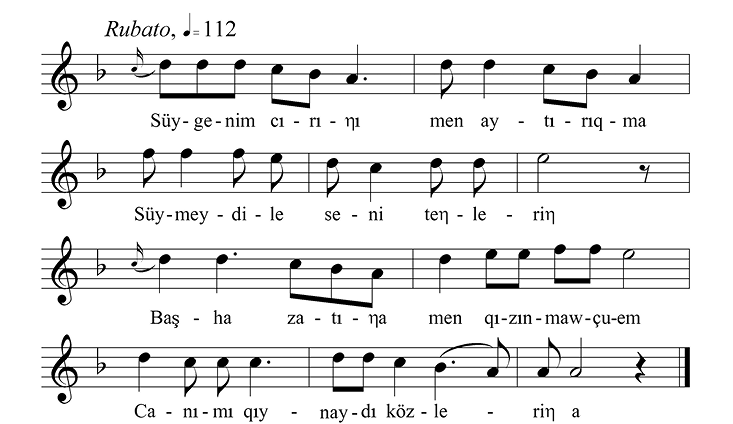
Ex.12.2. ”Jir” tune with 1(5)5 cadences
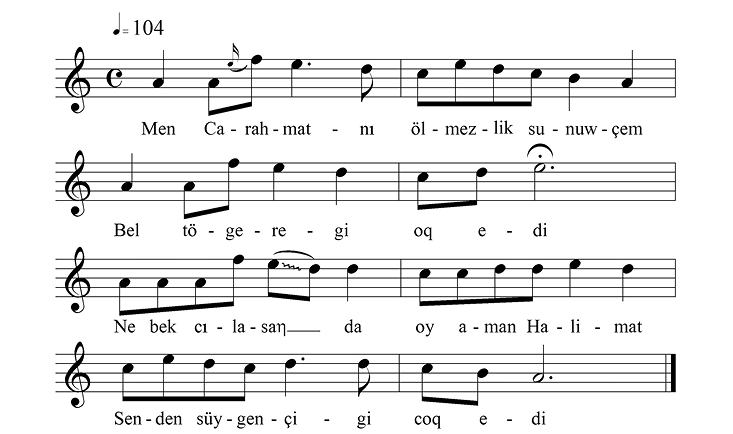
Ex.12.3a. ”Jir” tune with 1(5)4 cadences
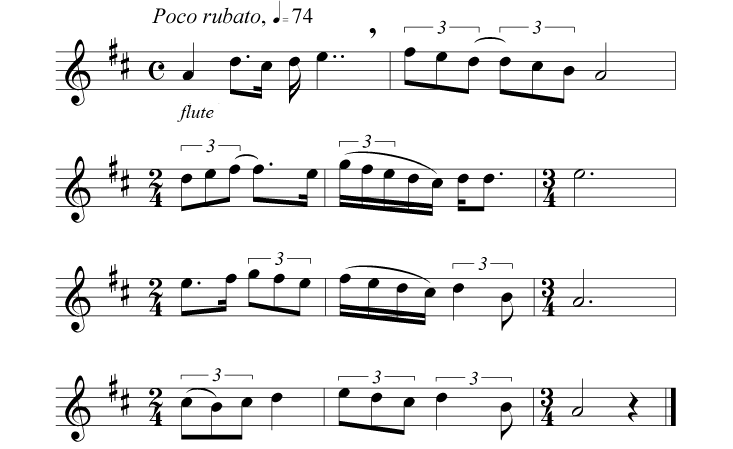
Ex.12.3b. ”Jir” tune with 1(5)1 cadences
Group 12.4. The majority of jir tunes have their first lines stop on degree 1 or 4/5. Less frequently, the first line ends on degree b3, rarely on 2. № 215–216 and Ex.12.4a of minor character, as well as № 217–219 and Ex.12.4b of mixolydian hues belong to the latter with (b)3(4/5)x cadences.
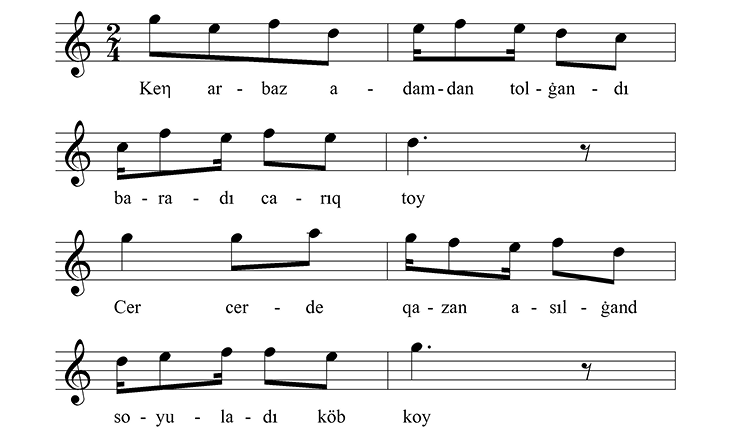

Ex.12.4a. ”Jir” tune with b3(4)4 cadences
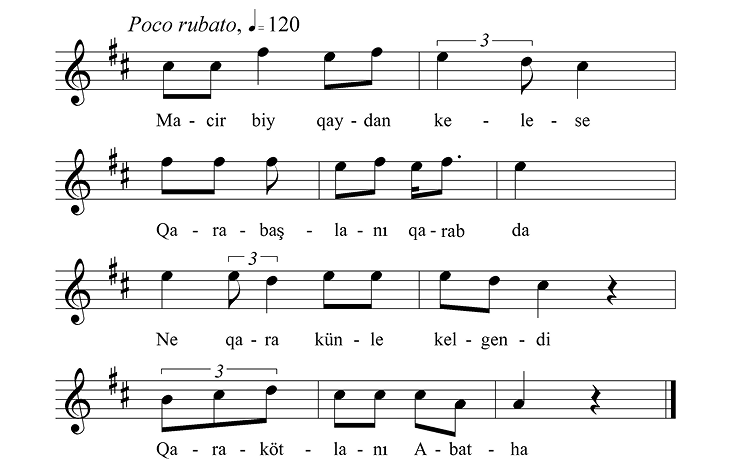
Ex.12.4b. ”Jir” tune with 3(5)3 cadences
Groups 12.5–12.8 have tunes with 4/5(4/5)x cadences. I range them by the melody outline of the first line. The first line in group 12.5 sinks in the middle, while that in group 12.6 rises or is hill-shaped. The first line in group 12.7 has two small mounts, that in group 12.8 is a tall hill and the first line in group 12.9 descends from high. All groups have minor and major character tunes alike.
Though the items in 12.5 start like those in 12.2, with a valley in the middle of the first line, but their second line ends high on degree 4/5. Typical
is the AB4-5AB form. Here belong the popular Aeolian-Phrygian № 220–221 and Ex.12.5a, and № 222–224 and Ex.12.5b of mixolydian character.
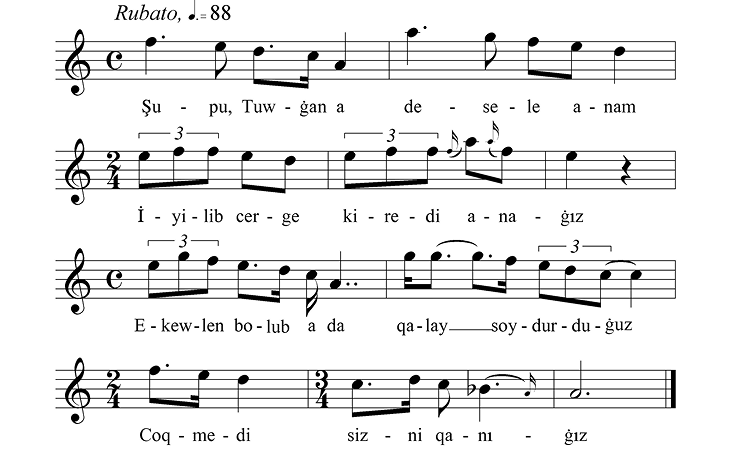
Ex.12.5a. ”Jir” tune with 4(5)b3 cadences

Ex.12.5b. ”Jir” tune with 4(5)4 cadences
The first line of tunes in group 12.6 is ascending or hill-shaped, the their form being ABCD and AB5CB typically. The second line is often high, as can be suspected from the (5) main cadence. Line 3 is often varied and line 4 mainly descends to the base note from around degree 7/5. Its tunes include
№ 225–229 and Ex.12.6a of an Aeolian-Phrygian character and the popular mixolydian № 230–234 and Ex.12.6b.
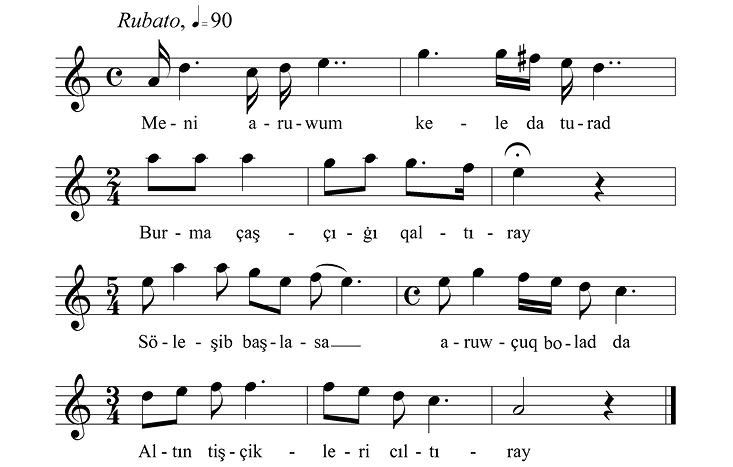
Ex.12.6a. ”Jir” tune with 4(5)b3 cadences
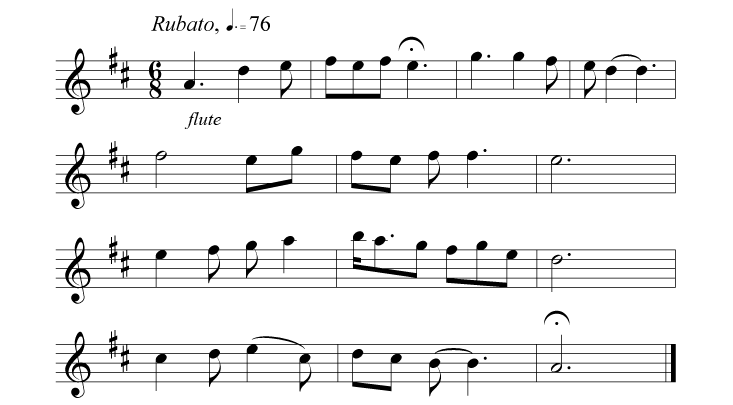
Ex.12.6b. ”Jir” tune with 4(5)4 cadences
In line 1 of group 12.7 tunes there are two small bulbs settling on E/D or a descent to E. Lines 2 and 3 are often high, though line 3 can be highly diverse, moving low or high, or even often descending to the base note or degree VII in mid-line (e.g. № 241). The group contains the very popular aeolian-Phrygian № 235–243 and Ex.12.7a as well as the mixolydian № 244–245 and Ex.12.7b.
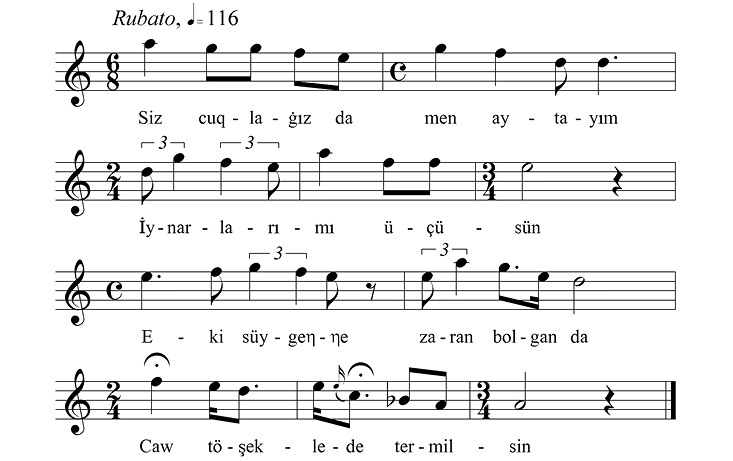
Ex.12.7a. ”Jir” tunes with 4(5)4 cadences

Ex.12.7b. ”Jir” tune with 4(5)5 cadences
The tunes in group 12.8 – most of them of minor character – trace a high E/D–A’–E/D hill in their first line. Line 2 also often outlines a tall mount, and more or less exact fourth-fifths-shift between lines 2 and 4 are also frequent, e.g.: AB4CB (№ 247), AB4-5CB (№ 250), A5B4-5AB (№ 248) and even A5B5AB (№ 249). The melodies № 246–253 and Ex.12.18a of Dorian character and № 254–255 and Ex.12.8b of a mixolydian hue belong here.
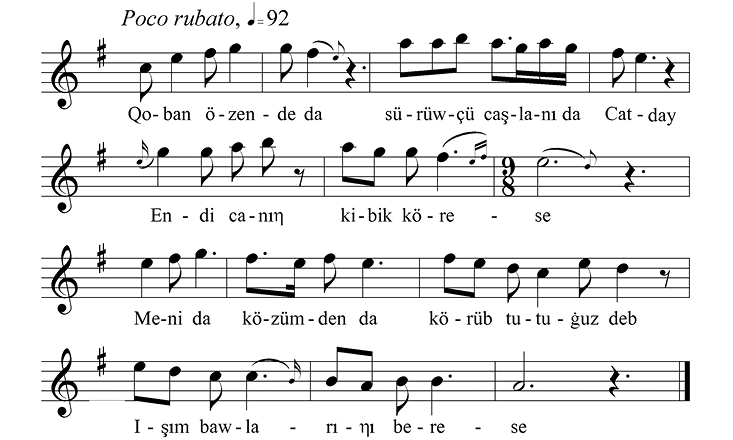
Ex.12.8a. ”Jir” tune with 5(5)4 cadences
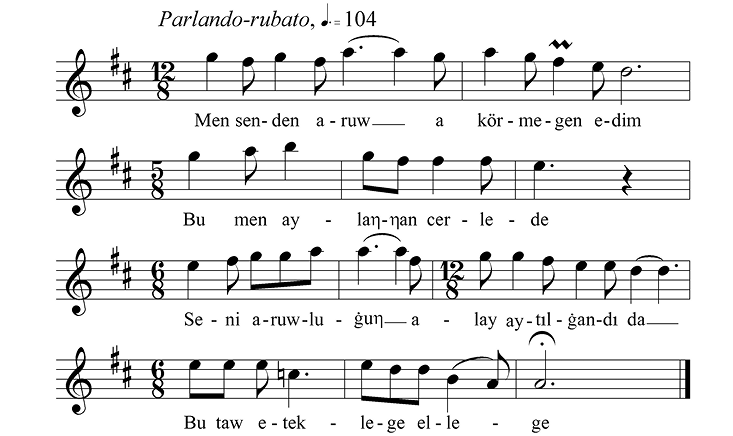
Ex.12.8b. ”Jir” tune with 4(5)4 cadences
The melodies in the last jir group (12.9) begins with a line descending from around A’, the second line is also often high, and line 3 may be high or low, bringing the greatest variability to the tunes, anyway. Forms ABCD, AB5CB (№ 257), AB4-5CB (№ 256) are very frequent, with some special schemes also occurring, e.g. ABAC (№ 266). Many tunes of Aeolian-Phrygian character in this group have 4(5)b3 cadences, and the cadences of some melodies are 8(5)x (№ 265–266). The cadences of the mixolydian tunes are more diverse. The highly popular № 256–266 and Ex.12.9a of a minor scale and equally popular № 267–276 and Ex.12.9b of mixolydian character belong here.
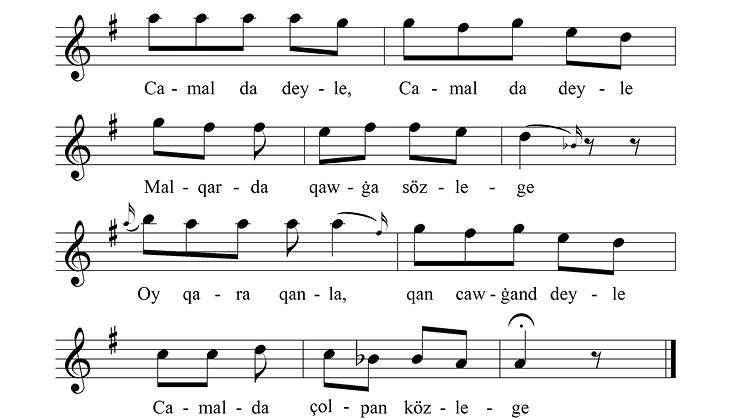
Ex.12.9a. ”Jir” tune with 4(4)4 cadences
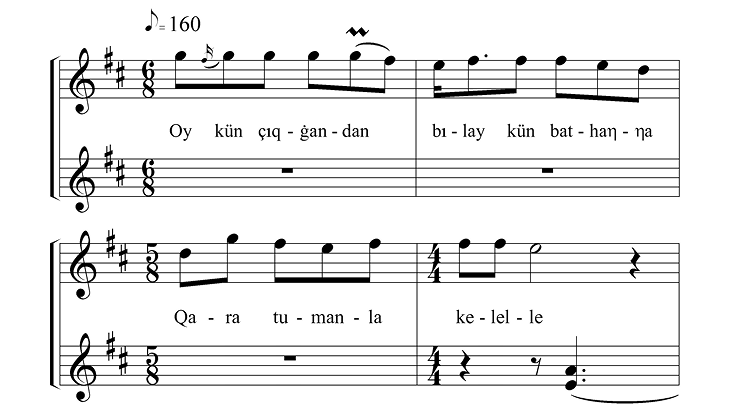
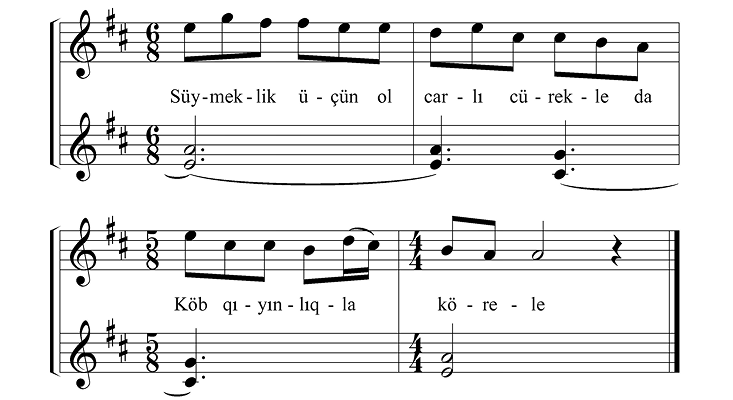
Ex.12.9b. ”Jir” tune with 4(5)1 cadences
